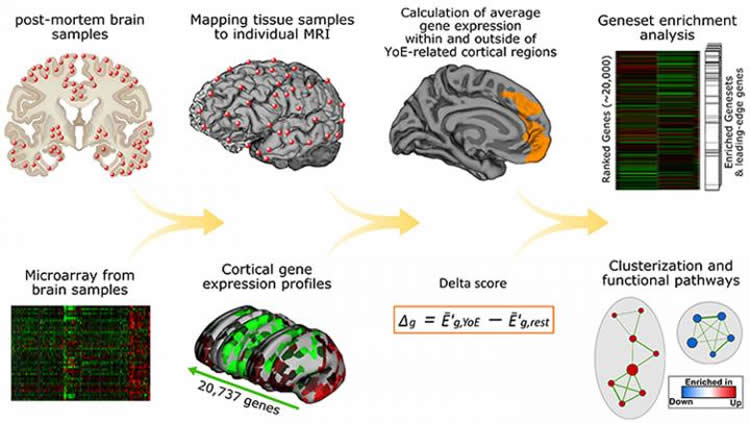Summary: Neuroimaging reveals those who have spent more years studying have increased cortical thickness in the medial prefrontal cortex, anterior cingulate and orbitofrontal areas of the brain. Researchers also identified enhanced gene expression profiles in these brain regions that promote information processing and provide protection against some age-related neurodegenerative diseases.
Source: SfN
Prefrontal brain regions linked to higher educational attainment are characterized by increased expression of genes involved in neurotransmission and immunity, finds a study of healthy older adults published in Journal of Neuroscience. The identified genes and molecular pathways could provide insight into factors that help keep the brain sharp in old age.
In their study of 122 Spanish adults, David Bartrés-Faz (University of Barcelona), Michel Grothe (German Center for Neurodegenerative Diseases), and colleagues found the medial prefrontal, anterior cingulate, and orbitofrontal cortices – brain regions important for working memory and decision-making – were thicker in individuals who completed 15 years of formal education compared to individuals with fewer years of education.
The researchers used data from the Allen Institute Human Brain Atlas to identify enhanced gene expression profiles in these brain regions that promote information processing and clearance of neuronal debris related to neurodegenerative diseases.

In addition to confirming previous associations between educational attainment and cortical thickness, these results provide a direction for future molecular studies of brain health in the elderly.
Source:
SfN
Media Contacts:
David Barnstone – SfN
Image Source:
The image is credited to Bartrés-Faz et al., Journal of Neuroscience (2019).
Original Research: Closed access
“Characterizing the molecular architecture of cortical regions associated with high educational attainment in older individuals”
David Bartrés-Faz, Gabriel González-Escamilla, Lídia Vaqué-Alcázar, Kilian Abellaneda-Pérez, Cinta Valls-Pedret, Emilio Ros and Michel J. Grothe. Journal of Neuroscience 8 April 2019, 2370-18 doi:10.1523/JNEUROSCI.2370-18.2019
Abstract
Characterizing the molecular architecture of cortical regions associated with high educational attainment in older individuals
Neuroimaging investigations have revealed inter-individual variations in anatomy, metabolism, activity, and connectivity of specific cortical association areas through which years of education (YoE), as a common proxy of cognitive reserve, may operate in the face of age- or pathology-associated brain changes. However, the associated molecular properties of YoE-related brain regions and the biological pathways involved remain poorly understood. In the present study we first identified brain areas that showed an association between cortical thickness and YoE amongst 122 cognitively healthy older human individuals (87 female). We subsequently characterized molecular properties of these regions by studying brain-wide microarray measurements of regional gene expression. In accordance with previous studies, we observed that YoE were associated with higher cortical thickness in medial prefrontal, anterior cingulate and orbitofrontal areas. Compared to the rest of the cortex, these regions exhibited a distinct gene expression profile characterized by relative up-regulation of gene sets implicated in ionotropic and metabotropic neurotransmission as well as activation of immune response. Our genome-wide expression profile analysis of YoE-related brain regions points to distinct molecular pathways that may underlie a higher capacity for plastic changes in response to lifetime intellectual enrichment and potentially also a higher resilience to age-related pathologic brain changes.
SIGNIFICANCE STATEMENT
We combined a neuroimaging-based analysis with a transcriptome-wide gene expression approach to investigate the molecular-functional properties of cortical regions associated with educational attainment, as a commonly used proxy for cognitive reserve, in older individuals. The strongest association with education was observed in specific areas of the medial prefrontal cortex, and these areas exhibited a distinct gene expression profile characterized by relative up-regulation of gene sets implicated in neurotransmission and immune responses. These findings complement previous neuroimaging studies in the field and point to novel biological pathways that may mediate the beneficial effects of high educational attainment on adaptability to cope with, or prevent, age-related brain changes. The identified genes and pathways now warrant further exploration in mechanistic studies.






